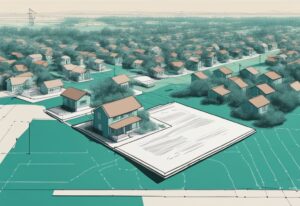
Have you ever wondered ‘What is RVM in Real Estate’? You’re not alone! This tool, the REALTORS Valuation Model, is increasingly utilized in the real estate industry for its unparalleled precision in property assessments. But just what makes it so effective?
In simple terms, RVM combines thorough MLS data and exhaustive public records to derive highly accurate property valuations. More accurate than traditional methods, it’s a fantastic tool whether you’re a seller hoping to pitch your property at the perfect price or a buyer seeking value for money. This article will, therefore, illuminate the world of RVM, highlighting its significance and benefits in the ever-evolving real estate market.
Intrigued? Of course, you are! So why wait? Let’s dive deeper and uncover the answers together!
RVM Explained: What Is It?
RVM stands for REALTORS Valuation Model or Realtor’s Valuation Model. It is a sophisticated tool designed to deliver accurate property value estimates by leveraging both on-market and off-market MLS (Multiple Listing Service) listing data, coupled with publicly recorded sold data. This unique approach integrates extensive data sources, resulting in one of the most precise estimations provided by the Realtors Property Resource (RPR).
What is RVM in real estate? Essentially, RVM is a valuation model that offers a comprehensive and real-time depiction of property values. It amalgamates various data points from MLS listings—both properties currently on the market and those off-market—with public records that include sold data. This fusion ensures that the RVM remains a leading tool for determining fair market value.
RPR prioritizes accuracy through RVM by utilizing continuous independent testing to ensure high performance. This meticulous approach allows real estate professionals to rely on RVM for the most up-to-date and accurate property valuations. By integrating this model, agents and brokers can effectively gauge the fair market value of properties, providing a dependable estimation before a property is listed for sale.
Importantly, RVM’s capability to combine detailed MLS data with extensive public records sets it apart, rendering it indispensable for real estate professionals focused on delivering precise property assessments. For those interested in understanding different types of contracts in real estate, it’s useful to learn what a unilateral contract in real estate entails. This ensures that homeowners, sellers, and buyers are equipped with the most accurate valuation possible, enhancing decision-making in a competitive real estate market.
How RVM Works in Real Estate Valuation
Key Data Sources for RVM
The REALTORS Valuation Model (RVM) in real estate hinges on the integration of multiple key data sources to provide accurate property valuations. The primary sources include on-market MLS listing data and off-market MLS listing data, which offer a wealth of details such as extensive property descriptions, high-resolution photos, and other vital listing information. Additionally, the RVM taps into publicly recorded sold data. These public records encompass essential details like property tax records and historical sale data, contributing to a robust database for valuations.
The combination of MLS data and public records ensures that the RVM captures a comprehensive picture of the property’s characteristics and market history. This multidimensional approach is designed to reflect the most up-to-date and relevant information, contributing to the credibility and precision RVM is known for in real estate valuation.
Frequent Updates: Keeping RVM Current
To maintain its accuracy and relevance, the RVM updates its estimated values twice a month. This frequent refresh ensures that the model reflects the latest market conditions and property data, which is critical in the dynamic real estate landscape. Each update considers new listings, recent sales, and changes in market trends to provide a current valuation.
Moreover, RVM goes through continuous independent testing to verify its performance and accuracy. This rigorous testing process involves comparing RVM estimates against actual sale prices and other benchmarks to ensure that it consistently delivers high accuracy and reliability. This commitment to continuous improvement through regular updates and stringent testing positions RVM as a leading tool in real estate valuation. To further understand advanced methodologies, you can explore what the Gator method in real estate involves and its impact on valuations.
RVM Versus AVM: What Sets Them Apart?
Comparing Data Inclusion
The primary difference when discussing what is RVM in real estate versus an AVM (Automated Valuation Model) lies in the scope and timeliness of the data they use. An RVM (REALTORS Valuation Model) leverages both on-market and off-market MLS data, along with comprehensive public records. This integration enables the RVM to mirror current local market conditions with remarkable precision.
In contrast, an AVM primarily depends on public records, which can lag behind actual market activity by 30 to 60 days. Such latency can make AVMs less adaptive to real-time market dynamics. Furthermore, RVMs employ forward-looking MLS data algorithms that enhance the relevance and accuracy of their property valuations. Imagine needing to price a property accurately—having the most current data at your fingertips could make all the difference.
Assessing Accuracy and Performance
When it comes to what is RVM in real estate compared to AVMs, accuracy and performance are standout factors. The RVM undergoes continuous evaluation by independent bodies, often showing higher accuracy and a stronger hit rate. This rigorous testing ensures that the RVM can be more precise than AVMs, which are typically reliable only if they estimate a selling price within plus or minus 10% of the actual price.
The superior accuracy of RVMs comes from merging detailed MLS information with public records, creating a solid foundation for property valuation. This extensive data integration allows RVMs to consistently outperform AVMs in delivering reliable property estimates. Think of it as having a seasoned local expert versus a generalist—the specialized knowledge makes all the difference.
Inside RVM: Essential Components
The RVM, or Realtor Valuation Model, is a sophisticated tool used in the real estate sector to estimate property values. By leveraging local market data and property specifics, RVM offers a nuanced and accurate valuation, making it an invaluable resource for buyers, sellers, and real estate professionals.
Comparable Properties: RVM’s Core
Comparable properties, often referred to as “comps,” play a crucial role in the RVM framework. These comps are selected based on their similarity to the property being evaluated, typically found within a 1-mile radius and sold in the last 12 months.

Why are comps so essential? They provide a benchmark, drawing on details like size, location, condition, and recent sale prices. By analyzing these facets, the RVM can generate a more accurate home valuation. Think of comps as the backbone of the RVM. Without them, determining a home’s market value would be like navigating a maze without a map.
Confidence Scores: How Trustworthy Is RVM?
Confidence scores in RVM estimates range from 0 to 5 stars and are pivotal in assessing the reliability of these valuations. A high confidence score—between 4 to 5 stars—indicates that the estimated value is highly accurate, generally within plus or minus 10% of the actual sale price. On the flip side, lower confidence scores suggest a broader estimate range, possibly within plus or minus 30%.
Several factors influence these scores, such as the recency and volume of sales data and the completeness of property information. For instance, a neighborhood with abundant recent sales and comprehensive property details will yield higher confidence scores.
On the other hand, incomplete data or scarce recent sales will inevitably lower the confidence score, reflecting greater uncertainty in the estimate. Understanding these confidence scores is crucial for assessing what is RVM in real estate.
These elements—comparable properties and confidence scores—underscore the significance of RVM in delivering accurate and reliable property valuations. The quality of data and robustness of methodology are key to ensuring these estimates are trustworthy.
Keep these points in mind the next time you look at an RVM estimate and you’ll have a deeper understanding of what it truly represents.
RVM in Practice: Real-Life Applications
Discover how RVM seamlessly integrates into real estate practices, offering both sellers and buyers invaluable insights and improved decision-making.
Seller’s Report: Cracking the Code
Ever wondered what is RVM in real estate? One practical application is within the Seller’s Report. These reports use RVMs to help homeowners pinpoint the best listing price for their property. With a thorough analysis of the property market and comparable sales, a Seller’s Report featuring RVM provides a clear understanding of the property’s potential market value.
This detailed analysis doesn’t just stop there. It assesses market trends, examines property conditions, and reviews recently sold comparables. The result? Competitive and accurate pricing that sets sellers up for success.
Unlock the Value with Property & Mini Property Reports
Another key aspect of what is RVM in real estate can be found in Property Reports and Mini Property Reports. These reports leverage RVMs to offer a comprehensive overview of a property’s value, accounting for market trends and comparable sales.
For buyers, these reports are a goldmine. They offer insights into fair market values, making informed decisions a breeze. Sellers, on the other hand, can recognize their property’s potential value and set realistic prices. Real estate professionals utilize these reports to provide clients with reliable, data-backed advice, ensuring well-informed and strategic decisions in the transaction process.
Why Use RVM? Top Advantages
Accuracy and Sophistication: RVM’s Hallmarks
When questioning what is RVM in real estate, one can’t overlook its remarkable accuracy. RVM stands out as a more precise automated estimation tool compared to AVMs. It integrates detailed MLS data with comprehensive public records, providing robust and dependable property valuations. This dual data approach enhances its reliability. Independent testing highlights RVM’s precision, showing its ability to consistently deliver sophisticated data integration. For real estate professionals and homeowners, this means more accurate evaluations every time.

RVM’s Unique Combination: Merging MLS Data & Public Records
RVM excels by uniquely merging both on-market and off-market MLS data with publicly recorded sold data. This comprehensive combination is key to understanding what is RVM in real estate. Detailed MLS information—like property descriptions, photos, and previous listing details—alongside public records such as property tax histories and sale transactions, ensures a more reliable and extensive valuation process.
This synthesis of diverse data points offers a nuanced and holistic assessment. It allows for meticulous property evaluations, making RVM a preferred choice for those seeking reliable and comprehensive property value estimates.
Limitations of RVM: Things to Keep in Mind
Understanding the limitations of RVM in real estate is crucial for accurate property valuation. Let’s explore some key challenges associated with this tool.
Handling Unique Properties: RVM’s Challenge
When thinking about what is RVM in real estate, it’s important to consider its limitations. One of the main challenges RVM faces is accurately valuing unique properties. Have you ever wondered how it fares with rural areas, agricultural lands, commercial spaces, or larger multi-family properties? These types of properties often don’t fit neatly into RVM’s valuation models.
Unique characteristics or recent upgrades might not be well documented, which makes the estimation process tricky. Add to that the incomplete nature of public records, and you have a recipe for less reliable estimates. For instance, in rural areas where property transactions are infrequent, the lack of comparable sales data can throw off the estimates.
How Data Completeness Affects RVM
The role of data completeness is another critical aspect of understanding what is RVM in real estate. The accuracy of RVM largely depends on the thoroughness of public records. Missing details like the number of bedrooms or bathrooms can drastically lower the confidence score of the RVM.
The confidence score tells us how reliable the valuation is. Incomplete data usually leads to a wider estimate range, making the valuation less precise. Also, if you’re dealing with areas where property sales rarely occur, the absence of recent transaction data can further diminish the RVM’s reliability.
So, for a robust property valuation, it’s essential to ensure that all key property facts are up-to-date and comprehensive. This will help improve the accuracy of RVM’s estimates.
By acknowledging these limitations, you can better interpret RVM estimates and make more informed decisions when it comes to property transactions. While RVM is a powerful tool for estimating property values, its effectiveness hinges on the quality and completeness of the data it uses.
Decoding RVM Results: Tips for Interpretation
The RVM, or Realtors Valuation Model, can be a powerful tool for estimating property values, but grasping its nuances is key. Here, we’ll delve into the critical aspects of interpreting RVM results to help you make informed decisions.
How to Read Confidence Scores
Understanding confidence scores in RVM is crucial. Think of them as a trust meter for your property’s estimated value. A high confidence score, typically in the 4 to 5-star range, means the estimate is very reliable, likely within +/- 10% of the actual sale price. Why so accurate? It’s usually because there’s a lot of up-to-date data from comparable properties.
But what about those lower scores, between 1 and 2 stars? They suggest a broader estimate range, often within +/- 30% of the sale price. This typically happens when data is sparse or outdated, so exercise caution with these estimates. Factors like how recent the sales data is, the completeness of property features, and the accuracy of public records all play a role in these scores.
Effect of Local Market Conditions On RVM
Local market conditions significantly impact RVM’s accuracy. The real estate market doesn’t exist in a vacuum; it’s shaped by economic shifts, seasonal changes, and regional demand fluctuations. Imagine a neighborhood experiencing a real estate boom – higher property valuations will follow due to increased demand.
Conversely, during a market cooldown, property valuations might drop. Understanding these local nuances is essential when you’re looking at RVM estimates. Considering current market trends and regional economic indicators can help align RVM results more closely with actual market conditions. This alignment ensures more strategic and informed real estate decisions, whether you’re buying or selling.
RVM or Professional Appraisal? Navigating Your Choices
Combining RVM and Professional Appraisal: A Balancing Act
In the landscape of real estate valuation, understanding what is RVM in real estate is crucial. However, it’s equally important to recognize that the RVM is not a one-size-fits-all solution. The REALTORS Valuation Model (RVM) provides a sophisticated estimate using comprehensive datasets, but it should complement rather than replace a professional appraisal.

The RVM tool leverages on-market and off-market MLS listing data along with publicly recorded sold data to offer a robust property valuation. However, it lacks the nuanced insights a professional appraiser brings. Real estate professionals conduct on-site evaluations, observe property conditions, and consider unique features and floor plans that an automated model might overlook. This direct observation can highlight aspects like recent renovations, landscaping, or notable structural integrity that significantly impact a property’s value.
Achieving a comprehensive valuation generally involves pairing the RVM with a Comparative Market Analysis (CMA). The CMA provides a clear picture based on similar properties that have recently sold in the vicinity, adding another layer of accuracy. Professional appraisals integrate market conditions, demand in the local area, and other qualitative factors into their assessments. They deploy a balancing act between the objective data provided by RVM and the subjective insights from physical property inspections.
In conclusion, while the RVM offers a highly accurate, data-driven property value estimate, it’s most effective when used collaboratively with a professional appraisal. Together, these tools equip buyers, sellers, and real estate professionals with a comprehensive understanding of a property’s market value, ensuring informed and strategic decision-making.
FAQs: All You Need to Know about RVM
Wondering about RVM and its role in real estate? Below, I’ll address some of the most common questions to help you grasp this key concept.
What exactly does RVM stand for?
RVM stands for REALTORS® Valuation Model. This sophisticated tool estimates property values by integrating MLS data and public records. Think of it as your property’s value, finely tuned with the latest and most accurate information available.
How often does RVM update its data?
RVM updates its estimated values twice a month. This frequent updating ensures valuations reflect the most current market conditions and property information available. So, you can trust that the values you’re seeing are always up-to-date.
Is RVM more accurate than AVM?
Yes, in most cases, RVM is more accurate than AVM. Why? Because it combines detailed MLS data with public records and undergoes continuous independent testing. This rigorous process confirms its precision and reliability, as highlighted by the final rule issued by six federal regulatory agencies to help ensure the credibility and integrity of models used in valuations for certain mortgages secured by a consumer’s principal dwelling, which you can read more about [here](https://www.consumerfinance.gov/about-us/newsroom/agencies-issue-final-rule-to-help-ensure-credibility-and-integrity-of-automated-valuation-models/). It’s like having a finely-tuned instrument always giving you the most precise reading.
Can I directly access RVM reports?
No, RVM reports are not publicly accessible. They can only be obtained through a Realtor® or via RPR platforms. This ensures that a professional guides you through the process, making it easier to understand and utilize the detailed information effectively.
Conclusion
When diving into what is RVM in real estate, it’s clear that understanding this tool is crucial for precise property valuations. The RVM blends detailed MLS data with publicly available information, creating highly reliable property value estimates. This integration makes it one of the most accurate tools in the real estate market.
However, it’s important to remember that despite its impressive accuracy, the RVM shouldn’t replace professional appraisals. Think of it as a complementary tool. While the RVM provides automated precision, a professional appraisal offers a hands-on evaluation, considering factors like property condition and unique characteristics that an automated system might miss.
Using both RVM and professional appraisals together gives a more complete understanding of a property’s market value. This balanced approach ensures that every aspect is covered, from automated data to human assessment, leading to more informed decisions for both buyers and sellers.





